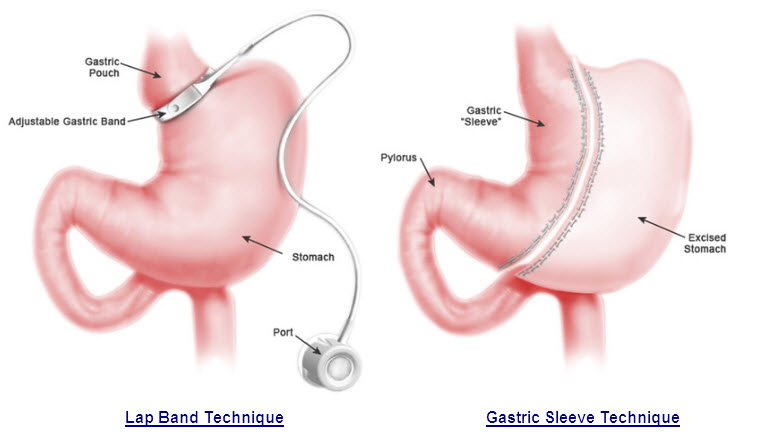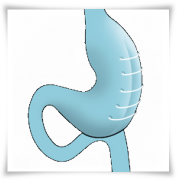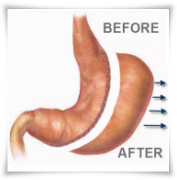Gastric Sleeve After Lapband
Getting a Gastric Sleeve after Lapband surgery may a necessity for a variety of reasons. The lap band may have slipped, it could be eroded or leaking fluid, or maybe it simply did not produce the results it was supposed to.
If the target weight has not been achieved, many surgeons prefer not to perform a second lap band surgery.
If you have experienced band slippage, erosion, or you haven’t reached your goal weight, the next logical step would be a gastric sleeve after lapband procedure has failed.
Click here to see a side-by-side comparison of the Gastric Sleeve vs Gastric Band.
Gastric Sleeve After Lapband – Revision Surgery
The gastric band technique is a restrictive method of weight loss, and if it doesn’t produce the results expected, or there are complications, the lap band technique can be altered. This is commonly referred to as Revision Surgery because the lap band procedure is being revised with another technique, such as the gastric sleeve or a bypass.
Revision surgery is where one failed technique is revised or slightly altered into another more successful technique. Think of the lap band as a stool, if one of the four legs breaks, it gets removed. The revision happens when the adjacent leg is removed, and both are replaced with longer legs that can form a backrest. It is still used for sitting, but it is now more comfortable. It is the same thing when you get a gastric sleeve after lapband failure.

The lap band works on a restrictive method as does the gastric band, so if the lap band fails for any reason, the best option is a gastric sleeve.
Gastric Sleeve After Lapband – Problems With The Lap Band
The 3 most common reasons why a gastric sleeve after lapband would needed are:
- Band Slippage
- Erosion
- Goal Weight Not Achieved
Band Slippage
One common complication with the lap band is slippage. Slippage could lead to a chronic or an acute condition that will require emergency surgery. In both instances, the lap band will not function as it should. Treating either of these issues may involve repositioning the band, replacing the band, removing the band all together and getting a gastric sleeve after lapband failure. One fact you should note is that once the band slips, the chance for a second slip is extremely high. If it slips a second time, the band must be removed completely. If the lap band must be removed, there is the obvious potential to regain the weight.
Erosion
Erosion of the lap band is another potential complication that would lead to a gastric sleeve after lapband surgery. Erosion can occur when the band wears a hole in the stomach, which makes the lap band ineffective. If this happens, the patient may vomit blood which is a symptom of erosion, however this usually only happens once.
The symptom of lapband erosion that is most frequently experienced is infection around the port site. The band erodes the stomach, saliva leaks through, and travels along the lapband tubing to the port site. The saliva causes an infection in the tissue beneath the skin of the lapband port, and it becomes red, puffy and uncomfortable for the patient.
The treatment for lapband erosion requires that the band be completely removed to allow the stomach time to heal. Unfortunately, the patient has no chance to lose any weight, and it is likely that the weight that has been lost (if any) will return.
Many bariatric surgeons will often recommend treating lapband erosion by converting the surgery to a gastric sleeve after lapband failure. Another option for conversion is the Duodenal Switch. Since the area of stomach that is eroded is already weak and is prone to leaking, gastric sleeve after lapband surgery can be completed quite easily with minimal cutting of the eroded area.
Goal Weight Not Achieved
There is the chance that the Lap Band will fail to produce the results expected, and the goal weight will not achieved. The Lap Band technique is a restrictive bariatric method, and some patients might not have the metabolism that is needed to lose excess weight with a gastric band. Other patients might not follow the diet properly and cannot be successful with a gastric band. This can lead to poor eating behavior which will ultimately result in failing to lose the weight, and even weight regain.
Why Get A Gastric Sleeve After Lapband?
Lap Band can be converted to any type of weight loss surgery, however, a patient has a better chance at success with another restrictive type of surgery, which is why most patient get a gastric sleeve after lapband failure. Evidence suggests that a properly managed lapband can over time provide results that are comparable to a gastric sleeve. This is because both procedures depend on restricting the quantity of food eaten due to a smaller stomach. Converting a patient to a gastric sleeve after lapband failure is the best option.
For those patients who only want restrictive weight loss surgery, the preferred option is the gastric sleeve after lapband failure. A gastric sleeve works by reducing the size of the stomach, which is basically how the gastric band works. Neither of these two procedures will alter the digestive system, so food is processed normally. There are no malnutrition issues, no major complications, and the side effects are minimal with both techniques. The only difference between the two is that the gastric sleeve permanently removes a large portion of the stomach where as the gastric band can be removed afterwards and is not permanent.
Even though they are based on the same principle, a gastric sleeve will result in more weight loss than a gastric band. If you have a lap band and want to avoid experiencing band slippage, erosion, or have not reached your goal weight, speak with your bariatric surgeon. Many surgeons will recommend revision surgery, converting to a gastric sleeve after lapband.

